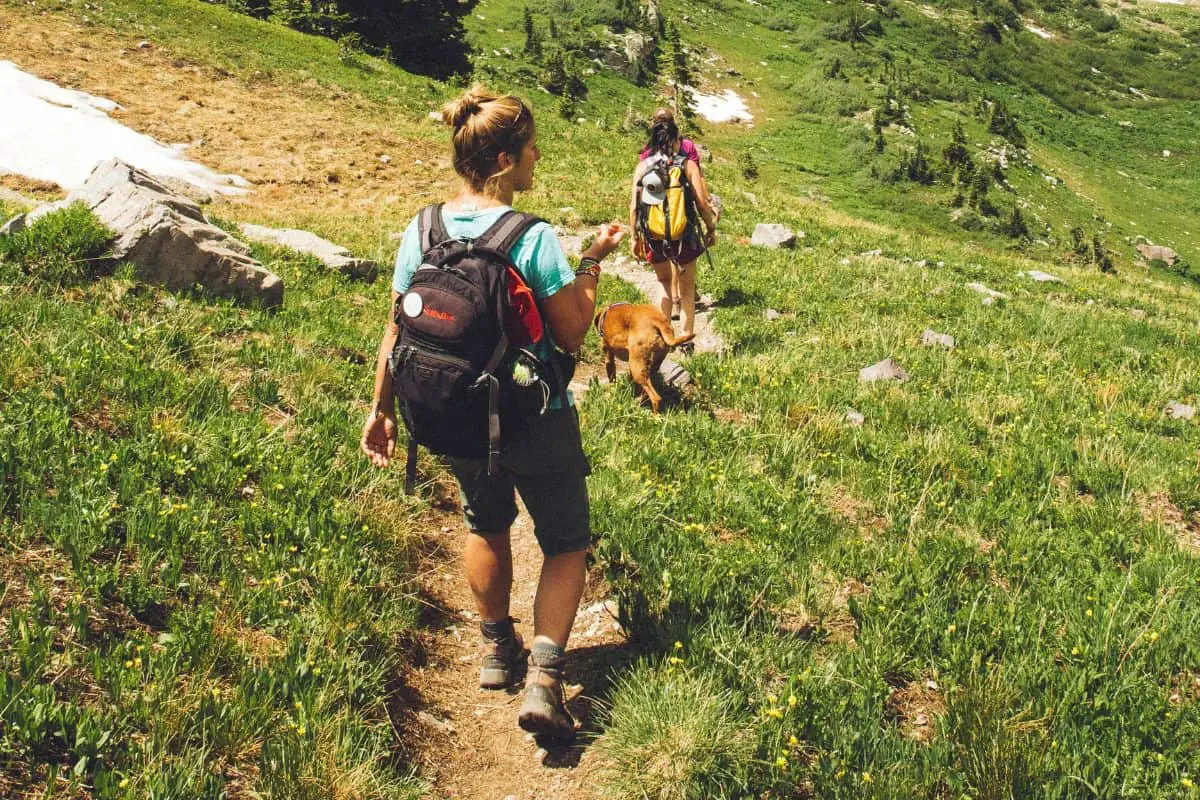Hiking is a compelling form of exercise that can effectively contribute to your weight loss goals. When you hike, you are engaging in a cardiovascular activity that not only burns calories but also improves your overall fitness.
Unlike some forms of exercise that can feel tedious, hiking offers a dynamic environment which can make your workout enjoyable.
As you traverse various terrains, the natural resistance and varying inclines increase your energy expenditure, which is beneficial for shedding pounds.
Hiking for Weight Loss
Incorporating hiking into your routine can also have a positive impact on your health beyond weight loss. It strengthens your muscles, improves your heart health, and increases your stamina.

However, to maximize weight loss, hiking should be paired with a healthy diet, as proper nutrition is essential in fueling your body for the physical demands of hiking and supporting a healthy metabolism.
To see significant weight loss results, consistency is key. Hiking regularly and challenging yourself with trails that have steeper grades can increase the number of calories you burn.
Keep in mind that the intensity and duration of your hikes, along with your body weight, play a pivotal role in how effective hiking can be for losing weight. So, lace up your boots, hit the trail, and enjoy the journey toward a healthier you.
Benefits of Hiking for Weight Loss
Engaging in hiking can contribute to your weight loss goals through a multifaceted approach, encompassing increased calorie expenditure, enhanced cardiovascular and muscle strength, and improvements in mental health.
Calorie Burn and Fat Loss
When you hike, you burn calories at a rate dependent on several factors such as your body weight, hike intensity, and terrain.
On average, hiking can burn between 430 to 480 calories per hour for a person weighing around 160 pounds. This caloric burn contributes directly to fat loss, as consistent hiking can generate a caloric deficit which is necessary for weight reduction.
Cardiovascular and Muscle Strength
Hiking is not just about burning calories; it’s also a robust cardiovascular exercise. It challenges your heart and lungs, leading to improved heart health.
The varied terrain of hiking trails requires your body to adapt continually, which strengthens multiple muscle groups. Over time, you build endurance and strength, making your muscles more efficient at burning fat.
Mental Health Improvements
Physical activity, including hiking, can positively impact your mental health. Regular hikes have been associated with lower stress levels and decreased cortisol, a stress hormone.
As you hike, your body also releases endorphins, which can improve mood and promote a sense of happiness. The connection with nature and the accomplishment of completing a hike can further enhance your mental well-being, contributing to a holistic approach to weight loss.
Hiking Essentials for Effective Weight Loss

Achieving weight loss through hiking involves more than just walking on a trail. It requires careful consideration of your nutritional needs, the gear you use, and how you approach each hike.
Proper Nutrition and Hydration
Nutrition is critical for maintaining energy levels throughout your hike. Prioritize a balance of carbohydrates for immediate energy, proteins for muscle repair, and fats for sustained fuel.
Consider these guidelines for your journey:
- Pre-Hike: Consume a meal rich in complex carbohydrates and protein about 1-2 hours before you start.
- During Hike: Snack on foods like nuts, fruit, or energy bars every hour to replenish your energy stores.
- Post-Hike: Eat a mix of carbohydrates and protein within an hour of finishing to aid recovery.
Hydration is equally important. Water is essential to help you maintain peak physical performance and supports healthy weight management by:
- Keeping you hydrated to optimize physical performance.
- Helping to suppress appetite and prevent overeating after your hike.
Recommended Hydration:
- Before Hike: Drink 17-20 oz of water 2-3 hours prior.
- During Hike: Drink about 7-10 oz every 10-20 minutes.
- After Hike: Rehydrate based on the extent of sweating – approximately 24 oz for every pound lost.
Appropriate Hiking Gear
Choosing the right gear is vital for a safe and comfortable hiking experience.
Ensure you have:
- Footwear: Durable, supportive boots or shoes designed for the terrain.
- Backpack: Lightweight yet spacious enough to carry essentials without adding unnecessary weight.
- Clothing: Moisture-wicking fabrics and layers to adapt to changing weather conditions.
- Protection: Sunscreen and a hat to protect against sunburn, sunglasses for eye protection, and a first aid kit for emergencies.
- Navigation: A compass or GPS device to keep you on the right path.
Read next – Best hiking hats for men and hats for women.
Pacing and Trail Selection
Pace and trails selection can directly influence your weight loss efforts.
To burn calories effectively:
- Start with trails that match your current fitness level and gradually increase difficulty.
- Maintain a steady pace that keeps your heart rate in the fat-burning zone.
- Choose routes with a mix of inclines for maximum calorie burn.
Trail Difficulty (Choose accordingly):
- Beginner: Flat, even paths.
- Intermediate: Varied terrain with moderate inclines.
- Advanced: Steep, uneven terrain with significant elevation gain.
By focusing on proper nutrition and hydration, equipping yourself with the right hiking gear, and smartly choosing your pace and trails, you’ll optimize your hikes for weight loss and overall health.
Physical Considerations and Safety Measures

When embarking on a weight loss journey through hiking, your safety and the prevention of injuries are paramount.
Tailoring your hiking experience to your personal fitness and age level is vital for a successful and healthy outdoor adventure.
Injury Prevention and Management
Injuries can occur on the trails, but you can mitigate the risks by taking precautions.
Before heading out:
- Wear appropriate hiking boots with ankle support to prevent sprains.
- Use hiking poles to improve balance and reduce the load on your knees.
- Carry a first aid kit for prompt care if an injury occurs.
Find out 🚶 How to Strengthen Knees for Hiking?
If you sustain an injury, follow these steps:
- Stop hiking and apply first aid as needed.
- Assess the injury; if it’s minor, rest until you feel better.
- If the injury is severe or doesn’t improve, seek prompt medical attention.
Dehydration is also a common concern:
- Drink plenty of water before, during, and after your hike.
- Recognize signs of dehydration, which include fatigue, dizziness, and dry mouth.
Adapting Hiking to Age and Fitness Levels
Hiking can be a low-impact physical activity, which makes it suitable for many age groups and fitness levels.
To adapt hiking to your needs:
- Start with easier trails and gradually increase difficulty as your endurance and strength improve.
- For older adults or those with lower fitness levels, select flat and even trails to reduce strain.
- Regardless of age, warm up before your hike and cool down after to prevent stiffness and soreness.
- Listen to your body and rest when needed to avoid overexertion.
Remember, safety is about understanding your limits and being prepared. Hiking can be a part of your weight loss strategy if you approach it with care and awareness of your physical capabilities.
Planning and Goal Setting for Hiking

Effective planning and goal setting are fundamental to utilizing hiking as a means for weight loss.
Adopting strategic targets and tracking your progress can significantly enhance your hiking experience and aid in achieving a healthy weight through fat burning and muscle mass increase.
Setting Achievable Targets
To begin, set clear and achievable goals for your hiking endeavors.
Consider your current fitness level and weight to customize a plan that suits your abilities and weight loss ambitions.
- Start with short, manageable hikes and gradually increase the difficulty and duration as your endurance builds.
- Aim to integrate thru-hiking trips, where feasible, as they involve extended periods of hiking over several days and can intensify the fat-burning process.
- Remember, incrementally increasing your muscle mass through consistent hiking can contribute to a higher metabolic rate, thereby accelerating weight loss.
Monitoring Progress and Adjusting Goals
It’s crucial to monitor your progress and be willing to adjust your goals as needed.
Here are some ways to keep track:
| Activity | Target | Progress Checkpoint |
|---|---|---|
| Distance Hiked | Specific number of miles/km per week | Weekly review |
| Hike Difficulty | Gradually transition from easy to challenging trails | Monthly assessment |
| Weight Loss | Set a realistic weight loss target per month | Bi-weekly weigh-ins |
- Use a journal or app to log your hikes, noting the distance, terrain, and calories burned.
- Listen to your body and adjust your targets if you’re consistently feeling overly fatigued or if you are not meeting your expectations.
- Ensure your goals promote a healthy weight loss: a slow and steady drop in pounds rather than a rapid decrease is often more sustainable and healthier in the long term.
By setting measurable targets and adapting them based on regular progress evaluations, you’ll maintain a clear path toward your weight loss objectives through hiking.






